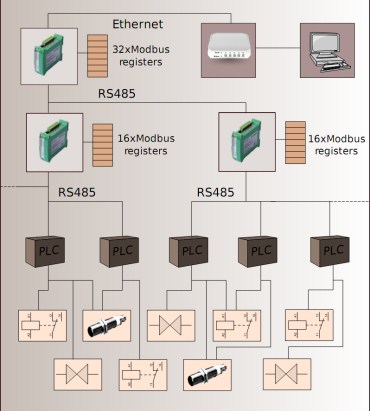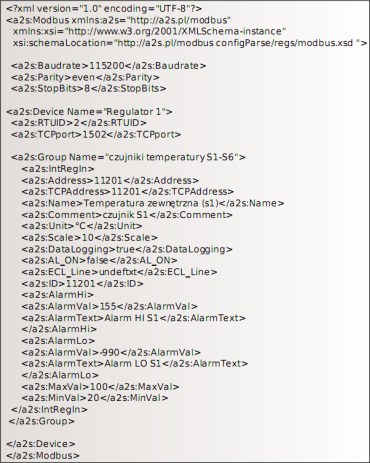|
Product description and examples of applications Device description NPE – Modbus Modbus is popular in the industry a communications protocol entered by the company Modicon. Initially only applied in programmable controllers of this company. Over time resulting in versions for the serial port and Ethernet. So necessary became devices including a conversion between these various Modbus. Purpose of product NPE – Modbus is conversion (proxy) between protocols MODBUS RTU (RS232/RS485), (ASCII), and Modbus TCP/IP. It allows you to communicate with devices running only interfaces RS232 or Ethernet network, providing the ability to use all its advantages, and easy data exchange between information systems, and layouts, industrial automation. On fig. 2 showed the flowchart of device. From the Ethernet interface converter acts as a slave on the selected TCP port. IP address can be set statically or through DHCP. Question mudbus from Ethernet are redirected to one of the serial ports (RS232 or RS485), where are available for devices as Modbus-Slave. NPE – Modbus is for these devices Mudbus-Master. Mapping of the appropriate mudbus address is made by using the configuration file in XML format. The converter also creates a relational database (SQLite) with individual mudbus registers, refreshes with configurable frequency. NPE – Modbus has the Linux operating system, the database may therefore be interface for other applications, such as Web server.  Fig. 2 The flowchart of device.  Fig 3: NPE – Modbus as the hub Web based on standard RS485 can work up to 32 devices. NPE – Modbus allows you to access the registers of Modbus each under a single IP address of an Ethernet network, on its different ports. Converters NPE – Modbus can therefore work together, creating a multi-level structure used as hubs, expanding capabilities of end supervising units based SCADA systems (fig. 3), or the same act as such units. As mentioned previously NPE – Modbus works under Linux operating system. Therefore supports standard protocols such as FTP, Telnet, NFS or DHCP. Thanks to supplied toolchain which the main part of the compiler is GCC, you can create your own applications to extend its functionality. |
 Fig 1: The appearance of the device Configuration details Configuration of mapping Modbus registers is made over the file in XML format. On fig. 2 shows a simple example configuration file. It defines one mudbus register input - type (input register) on the device ID 2 on side of the serial port and address Modbus 11201. Ethernet access to the registry will be possible under the same Modbus address, on port 1502 of IP converter address. The importance of other items in a configuration file, see the tab. Using XML allows you to easily edit the settings by using any text editor.  Fig 4: The structure of the sample configuration file Data logger function The presence of database allows you to read values from the acquisition with wanted frequency. When you move them to your desktop computer through the FTP server may be subjected to further treatment and visualization. TechBase Sp. z o. o. info@a2s.pl |
Tab 1: Description of the elements of the configuration file
| Name of the element | Meaning |
| Baudrate | Transmission speed for the serial port |
| Parity | Parity (odd/even/none) |
| StopBits | The amount of stop bits |
| Device | The beginning of the section to define a new Modbus-Slave device |
| RTUID | mudbus slave ID in the network on the serial port side |
| TCPport | mudbus master TCP port that corresponds to the RTUID mudbus slave |
| Group | The beginning of the mudbus section group registers |
| IntRegIn | The beginning of the definition mudbus input registry (input register) |
| IntRegOut | The beginning of the definition of mudbus holding registry (holding register) |
| Address | Address of mudbus registry on the serial port side |
| TCPAddress | Address of mudbus registry on the Ethernet |
| Name | Name of the registry |
| Comment | Comment |
| Unit | Unit symbol |
| Scale | Scale |
| DataLogging | Mark that identifies the entry into the database (true/false) |
| AL_ON | Mark that identifies the activity alarm (true/false) |
| ECL_Line | An additional parameter to any use |
| ID | An additional parameter to any use |
| AlarmHI | The beginning of the section that defines upper alarm |
| AlarmLO | The beginning of the section that defines lower alarm |
| AlarmVal | Upper value alarm |
| AlarmText | Lower value alarm |
| MaxVal | Maximum registry value |
| MinVal | Minimum registry value |
Articles in Categories: Modbus RTU TCP
Collapse

|
Selection Guide |
|
Selection Guide - Modbus RTU TCP - Router
Read article » |



 Gateway
Gateway

